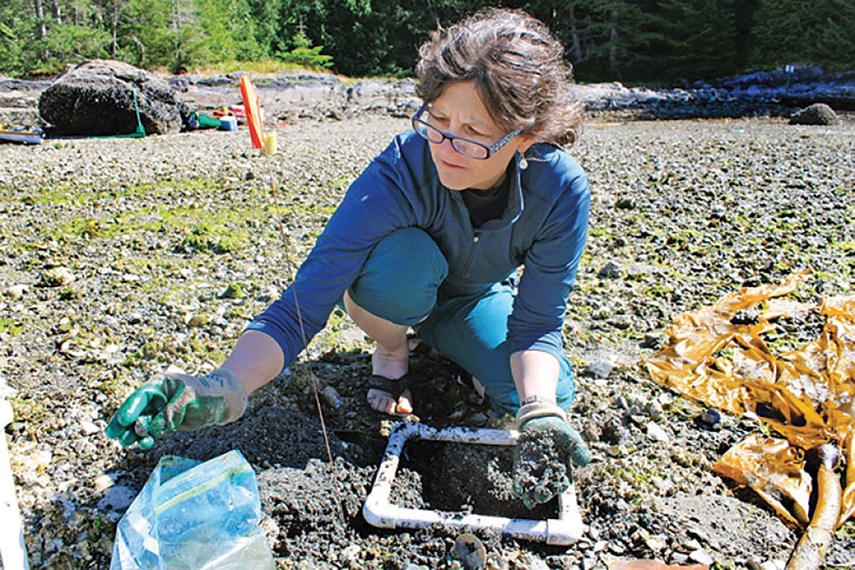SFU’s Faculty of Environment 2020 Dean’s lecture series: The New Power Couple: Traditional ecological knowledge and western science unite to inform sustainable management of clams featuring speakers Dana Lepofsky (SFU Archaeology), Oqwilowgwa Kim Recalma-Clutesi (Qualicum First Nation) and Xanius Elroy White (Heiltsuk Nation and SFU Alumnus), SFU Harbour Centre, 515 West Hastings, Room 1900, Feb. 6, 7 p.m. Free admission. For more information visit sfu.ca/fenv/events/Deans-Lecture-Series/2020-dean-s-lecture-series/the-new-power-couple.
On Feb. 6 at SFU Harbour Centre, Deep Cove resident Dana Lepofsky, a professor of archeology at Simon Fraser University, is part of a panel discussing how Western scientists and Indigenous knowledge-keepers are joining together to study “clam gardens” – the ancient rock-walled intertidal management structures created by coastal First Nations to increase clam production.
As an archeologist, Lepofsky has literally done digs in her own backyard studying the ancestors of the Tsleil-Waututh, but she is particularly known for her work further up the coast where she has focused her research on clam gardens on Quadra Island where both the Coast Salish Klahoose and Kwakwaka’wakw Cape Mudge groups have historical connections, as well as in Bella Bella with the Heiltsuk First Nation.
“Every bit of the northern Quadra landscape is covered in clam gardens,” Lepofsky told the North Shore News in a story published in 2016, “Clam gardens provide new perspectives on First Nations history.
“You can count on one hand the number of beaches that don’t have them. But even on Quadra, in ideal conditions where the sea level is dropping, we only get three hours a day, five days a week, four months of daylight hours a year. That’s how many hours we get to see these things.”
“Clam gardens” is an English term that fisherman Billy Proctor learned from Kwakwaka’wakw elders along B.C.’s central coast and passed along to John Harper. Indigenous groups that built and maintained them had various names for the rock formations they built along the shoreline. The Tla’amin referred to them as “wuxwuthin” in their Island K’omoks, while “lo xwi we” (“place of rolling rocks together”) was another term used in Kwak’wala. The Nuu-chah-nulth word “t’i’mi’q” refers to a beach where “rocks were removed or thrown aside.”

Lepofsky participated in a dig with the Tsleil-Waututh and a team of student researchers at the Cove Cliff Site (Say-umiton) in North Vancouver’s Strathcona Park in the summer of 2000. Say-umiton was a major settlement along with Tum-tu-may-whueton (Belcarra), Whey-Ah-Wichen (Cates Park), Sleil-Waututh (IR 3), and two locations at the mouth of Seymour River and in Port Moody Arm.
The excavations at the Cove Cliff/Say-umiton site revealed three historic levels of occupation dating back 3,000 years. Most of the archeological sites in Burrard Inlet and up Indian Arm have been identified as shell middens.
Anthropologist Jesse Morin says in “Tsleil-Waututh Nation’s History, Culture and Aboriginal Interests in Eastern Burrard Inlet” (an expert report prepared in for the Tsleil-Waututh Nation to provide evidence in relation to Trans Mountain pipeline ULC’s Trans Mountain Expansion Project application): “Shellfish comprised a major portion of Tsleil-Waututh’s diet, and were used in both their social and economic interactions with other Coast Salish people. Tsleil-Waututh village location was in part determined by proximity to shellfish beds. . . . Shellfish were served at feasts and potlatches, and exchanged to groups who lacked direct access to shellfish. Tsleil- Waututh would have exchanged smoked/dried clams to lower Fraser River Coast Salish, Squamish, and Interior Salish groups. Other First Nations, especially those lacking direct access to rich shellfish beds (e.g., Musqueam, Squamish, Kwantlen, Katzie), probably married into Tsleil-Waututh families to obtain access to such resources.”
Two-metre deep shell middens along the shoreline are evidence that shellfish were once a staple food of the Tsleil-Waututh but post-contact toxicity levels in Burrard Inlet have made it impossible to maintain clam gardens. Without knowing what clam gardens were, industrialization bulldozed clam gardens out of existence along most of the coast.
Western science and Indigenous knowledge-keepers are joining forces to revive the ancient tradition. The Clam Garden Network, a group of First Nations, academics, researchers, and resource managers from coastal British Columbia, Washington State, and Alaska, is working together to understand how Indigenous cultures used intertidal resources and ecosystems. Clam Gardens are the starting point for their research with the relatively untouched Quadra Island playing an important role in studying traditional practices.
The talk is free and open to the public. Reservations are recommended as seating is limited.
For more information on Lepofsky’s research of shellfish mariculture visit: nsnews.com/entertainment/dossier/clam-gardens-provide-new-perspective-on-first-nations-history-1.2303510.
Orthographies of Indigenous languages have evolved significantly over the past decades during ongoing study and revitalization of the languages. Tsleil-Waututh is an anglicization of the hən̓q̓əmin̓əm̓ word səl̓ílwətaʔɬ, as is xʷməθkʷəy̓əm for the anglicized word Musqueam. For more information on hən̓q̓əmin̓əm̓, the Downriver dialect of Halkomelem, visit https://fnel.arts.ubc.ca/community/musqueam-nation/musqueam-language-and-culture.
For further reading:
Ancient Shellfish Mariculture on the Northwest Coast of North America by Lepofsky, Dana; Smith, Nicole F.; Cardinal, Nathan; Harper, John; Morris, Mary; (Elroy White), Gitla; Bouchard, Randy; Kennedy, Dorothy I.D.; Salomon, Anne K.; Puckett, Michelle; Rowell, Kirsten; McLay, Eric M., American Antiquity, Volume 80, Number 2, April 2015, pp. 236-259.
Clam Gardens: Aboriginal Mariculture On Canada’s West Coast by Judith Williams (New Star Books, 2006).



